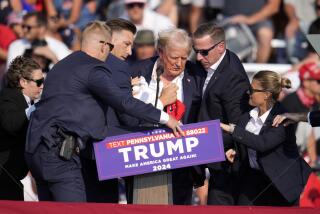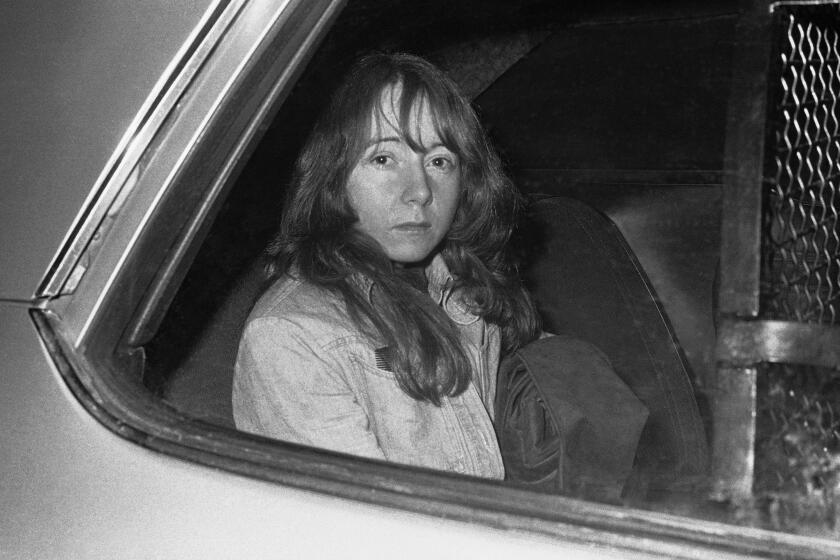A LOOK AHEAD * To guard against terrorism and protect leaders . . . Secret Service Scouring L.A. to Prepare for Convention
High above Los Angeles, theyâll be scouring rooftops and buildings with street-facing windows for potential sniper nests--and for spots for their âcounter-snipers.â
On the street, theyâll be sealing manhole covers and mailboxes and removing newspaper racks so terrorists canât hide bombs in them.
Some will do their work underground, wandering through storm drains and sewage tunnels for possible points of entry for terrorists.
In the weeks and months before the Democratic National Convention comes to Los Angeles, the Secret Service will be everywhere. And in typical fashion for the low-profile division of the U.S. Treasury Department, few if any people will notice them.
âWe like to do our work, run silent and run deep,â said Special Agent Jerry Wyatt, âand have nobody even know we were there.â
The maneuvers are just a small part of the Secret Serviceâs ambitious plan to protect President Clinton and his wife, U.S. Senate candidate Hillary Rodham Clinton; Vice President Al Gore and wife Tipper; both couplesâ children and a host of other VIPs when the Democrats gather Aug. 14-17.
The Secret Service also will be in charge of federal security measures at Staples Center, site of the convention and feared ground zero for every kook, wing-nut and potential troublemaker around.
âIâll basically be holding my breath from the time they get into town until the time they leave,â said Frank OâDonnell, special agent in charge of the Secret Serviceâs Los Angeles field office and the man in charge of the federal security operation.
No one has to tell OâDonnell what could happen if the Secret Service--or he, in particular--slips up.
They are well aware that it was in Los Angeles in 1968 that Robert F. Kennedy was assassinated after addressing Democratic presidential campaign supporters at the Ambassador Hotel and making a sudden detour into a crowded kitchen corridor.
The very next day, the Secret Service was assigned to protect presidential candidates, and OâDonnell--a veteran agent who has guarded all five presidents since 1976--says that nowadays, nothing is left to chance.
âWeâre always dragging them through kitchens and stairwells and loading docks, but we would never take a protectee through a place we have not checked out, secured . . . and done everything humanly possible to prevent an incident,â OâDonnell said.
Nevertheless, the RFK tragedy and assassination of his brother, President John F. Kennedy in 1963, serve as constant reminders to all agents that even intense planning and wall-to-wall security are no match for a lone assailant with a gun and a grudge.
Assassination attempts certainly are a Secret Service agentâs worst nightmare.
But for OâDonnell and his crew, there are myriad other things that could go very wrong at the largest gathering of politicos to converge on Los Angeles since the 1960 Democratic convention.
âEverywhere one of our VIPs may go, youâve got to prepare,â said retired Secret Service Agent Hamilton âHamâ Brown, who helped run security at the Democratic and Republican conventions in Miami in 1972. âIt is a massive, massive, massive undertaking.â
Since early September, OâDonnell, 52, has had four agents doing nothing but scoping out Staples Center, its environs and the dozens of hotels, restaurants, clubs and other places around Los Angeles at which more than 200 convention-related events will be held.
Ultimately, as many as 300 Secret Service agents will converge on Los Angeles, aided by scores of agents from the Treasury Departmentâs other units.
In all, theyâll oversee about a dozen official âprotecteesâ such as Clinton and Gore, and potentially dozens more senators, congressmen, Cabinet members and foreign diplomats, OâDonnell said.
He and others say that will be a particularly challenging task in sprawling Los Angeles, where long distances between delegate hotels and events, continual roadwork and traffic jams--not to mention protesters--promise to keep the Secret Service hopping.
The federal agents will work hand in hand with the Los Angeles Police Department, which is coordinating overall security and crowd control issues. They will also work with the California Highway Patrol and the Democratic National Convention Committeeâs security team.
âWeâll spend an inordinate amount of time making sure that that place is the safest place on the planet--not only the convention center itself, but the whole city of L.A.,â said Wyatt, a top deputy to OâDonnell who coordinated security at the 1992 Republican National Convention at the Houston Astrodome.
The work has already begun.
Agents are contacting the managers of buildings around Staples, surveying them on everything from the layout of their structures to how many windows open to the street.
âTheyâre coming soon,â said Edwin Pinos, general manager of the Windows restaurant atop the TransAmerica office tower, two blocks from Staples Center. âThey say theyâre going to take a look at the whole building, make sure itâs safe.â
Agents will also conduct criminal background checks of every waitress, busboy, cook and valet expected to be around the VIPs whom the Secret Service will protect.
If someone gets flagged, a criminal problem, even some other controversy, that person will be barred from the facility on the day of the convention event.
Secret Service agents also make sure that local hospitals are ready and able to handle any kind of emergency.
As for the heart of the convention--Staples Center--OâDonnell and others are hesitant to discuss exactly what they will do to secure it. But they acknowledge that they have devised secret ways to spirit VIPs in and out of the center without attracting the attention of potential protesters or assailants.
As convention time comes closer, agents and specially trained Secret Service technicians will poke around into every air-conditioning duct, electrical conduit, elevator shaft and anywhere else a person--or a bomb--could hide.
The Secret Service soon will set up a command post near Staples Center that will include an encrypted high-tech communications nerve center. That will allow it to track every motorcade, agent and VIP, and to put the information up on big screens in Los Angeles and Washington headquarters--a logistical war room of sorts.
The command post also will help the Secret Service deal with potential troublemakers.
Before and during the convention, the agents will rely on a continual flow of intelligence gathered by the FBI and local law enforcement. They also have their own list of thousands of âlookouts,â or people who are considered extremely dangerous and who may pose a threat to the president and others.
At least 10 metal detectors will be placed at entrances and key locations inside the convention center. Each will have a team of one or two agents and support staff. Other convention workers will check specially coded passes worn by delegates and others--and try to weed out those with forged credentials.
There will also be fluoroscopes, the conveyor belts that examine suitcases at airports, and scores of convention workers wielding hand-held metal detector wands.
The task of getting VIPs to Staples will require stealth as well, agents say. The Secret Service will check out several potential motorcade routes for each VIP, so, like a quarterback calling audibles, they can change at a momentâs notice. Thatâs done in part to avoid traffic jams, but for other reasons as well.
âItâs pretty much a last-minute call. If we donât know which way weâre going, the Jackal isnât going to know either,â OâDonnell said, referring to the 1973 film âDay of the Jackal,â in which an assassin is hired to murder French President Charles De Gaulle.
Along each route, armed agents will be strategically placed, and helicopters will hover above to look for signs of trouble. Agents and the LAPD will make sure the streets surrounding the convention site stay clear, and that motorcades donât get blocked by traffic or protesters.
OâDonnell is also going to make the call on which VIPs get the full security package of an armor-plated limousine surrounded by screaming sirens, a local law enforcement vanguard and a phalanx of Secret Service agents.
Agents will conduct surveillance on many alternate routes that those under protection will take when they leave their cars, either at Staples or other convention venues.
During convention week, every visit by a major VIP such as the president will trigger a massive deployment of agents, local police and support staff. That, in turn, could pose traffic problems, especially if thousands of protesters take to the streets around Staples Center as expected. It will be the LAPDâs responsibility to keep the streets clear and the CHP is in charge of ensuring open freeways.
Whether on the road, in a crowded room or on the convention floor, agents say they must be aware of all potential dangers. For that reason, they train exhaustively, studying every assassination attempt, major bombing and bio-terrorism incident so they can respond, said former Secret Service Director Eljay Bowron, now with a private protective agency.
For instance, the agency analyzed the 1995 incident in which terrorists overseas attacked the motorcade of former Soviet Foreign Minister Eduard A. Shevardnadze, firing rocket-propelled grenades that came so close that one bounced off his limousine.
âWe studied it so we donât have war stories like that to tell,â Wyatt said. âOur job is to make sure nothing [like that] happens.â
Even with all the potential pitfalls, OâDonnell and others are extremely confident about their ability to handle any type of problem--from traffic jams to the unspeakable worst.
The Secret Service will be everywhere and ânowhereâ at the convention. Brown likened the job of a Secret Service agent to that of a baseball umpire.
âIf you never notice them, theyâve done a helluva job,â Brown said. âYou do a tough job and make it look easy. Damn long hours just trying to get the job done, with no recognition.â
More to Read
Get the L.A. Times Politics newsletter
Deeply reported insights into legislation, politics and policy from Sacramento, Washington and beyond. In your inbox three times per week.
You may occasionally receive promotional content from the Los Angeles Times.










